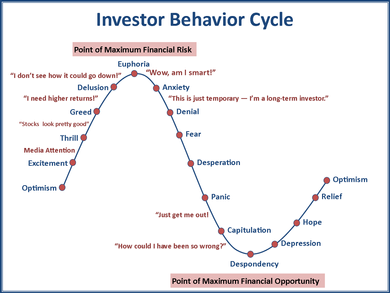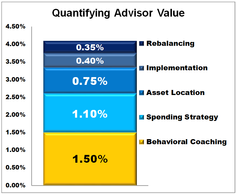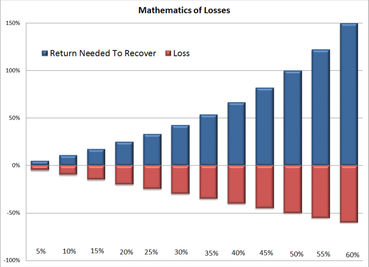
Point of Maximum Risk

It is human nature to take the current environment and project it into the foreseeable future. Whether it is a situation on the job, something with your kids, a sports team’s performance, or the stock market, this “recency” bias shapes the way we view most situations in life. The best way to overcome this human tendency is to use data & history as a guide. Life tends to move in cycles and a study of history can help us identify where we are in the cycle.
This is especially true with the stock market. Throughout history, researchers have studied the behavior cycle investors go through when it comes to investing. These scientists have identified some of the emotions that occur during each phase & illustrated to the right. Since 1992, SEM has provided investment portfolios designed to overcome the more common behavioral biases most of us exhibit at times. In addition, we help our financial advisors identify specific biases that may be present in order to structure a portfolio in such a way to diminish our emotional response to the markets, especially at the point of Maximum Financial Risk.
The Value of Using an Advisor
During the most recent bull market, we’ve seen a push to “do it yourself” investing (something that occurred during the last two bull markets as well). As the chart above illustrates, we go through a range of emotions as the market goes through the cycle. As we get closer to the “point of maximum financial risk”, investors become more confident. This often leads to mistakes when the market inevitably goes through a down cycle.

A recent study by Russell Investments identified a 2% annual “behavioral” cost over the past 33 years. Russell specifically cited the role of the financial advisor as helping clients stick to their long-term financial plans and skirting irrational, emotional decisions.
Even the “passive” fund company Vanguard conducted their own study of client accounts and came to a similar conclusion. Vanguard’s study showed an advisor can add 2.3% to 4.1% annually to their clients’ accounts through a variety of services. By far the largest contribution is the 1.5% Vanguard identified as “Behavioral Coaching”.
Whether the “Behavioral” coaching equals 1.5% or 2% per year, this can add up. Over a 30 year time period, this could lead to an additional $56,300 to $81,100 on a $100,000 investment.
The Importance of Minimizing Losses

SEM helps structure each portfolio allocation to the specific risk tolerance of our clients. Doing so should prevent a client from getting in a situation where they become nervous with the losses in their account, which could lead to an emotional reaction. In addition to this, the math behind investment losses shows us the importance of lowering risk in a portfolio.
If you lose 50% of a $100,000 investment, to recover you have to make $50,000 – a 100% gain. When the losses are low, the gain needed to recover them are also low. For instance, a 15% loss requires an 18% gain to recover. Right around the 20% mark, the gains needed to recover begin to escalate. If we lose less, we get to risk less to make up for the losses. So not only can we keep our emotions in check by minimizing losses, we have math on our side.
News & Notes:
2017 Year-End Tax Statements–what to watch for:
For taxable accounts, federal law requires your custodian to mail your IRS Form 1099 to you by January 31. Due to the increasing amount of reclassified mutual fund distributions, both of our custodians, Trust Company of America & TD Ameritrade have had this extended to February 15, 2018.
SEM strongly recommends you do not make your tax appointment until after February 15.
The 2017 Consolidated 1099 mailings to you includes cost basis and sales proceeds for investments sold during 2017. This provides essential information needed to complete your Federal Tax Filing Form 1040 Schedule D and Form 8949. Please wait until you receive Trust Company of America’s and/or TD Ameritrade’s 2017 Consolidated 1099 prior to completing your taxes.
For those clients that consolidated taxable accounts from TD Ameritrade to Trust Company of America, you will receive forms from both custodians.
SEM will be posting additional information on the tax reports early next year on our new website,
Download / Print version of the newsletter

What is ENCORE?
ENCORE is a Quarterly Newsletter provided by SEM Wealth Management. ENCORE stands for: Engineered, Non-Correlated, Optimized & Risk Efficient. By utilizing these elements in our management style, SEM’s goal is to provide risk management and capital appreciation for our clients. Each issue of ENCORE will provide insight into investments and how we managed money. To learn more about ENCORE Portfolios, please contact your financial advisor.
The information provided is for informational purposes only and should not be considered investment advice. Information gathered from third party sources are believed to be reliable, but whose accuracy we do not guarantee. Past performance is no guarantee of future results. Please see the individual Program Reports for more information. There is potential for loss as well as gain in security investments of any type, including those managed by SEM. SEM’s firm brochure (ADV part 2) is available upon request and must be delivered prior to entering into an advisory agreement.




